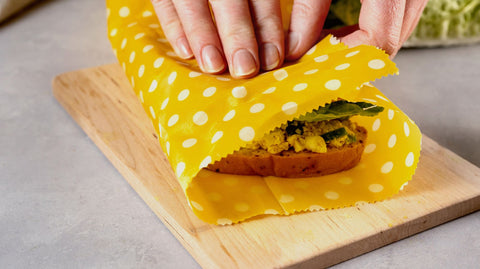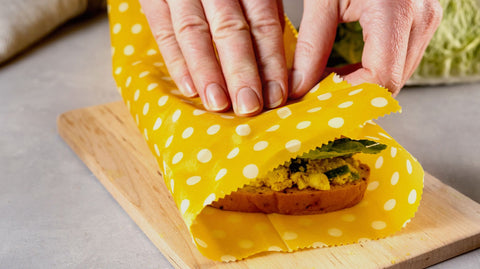In a world increasingly aware of plastic pollution and environmental sustainability, beeswax wraps have emerged as a practical and eco-friendly alternative to plastic wrap. Made from cotton fabric coated with beeswax, tree resin, and oil, these wraps provide a reusable and biodegradable solution for food storage.
Unlike plastic wrap, which contributes to landfill waste and ocean pollution, beeswax wraps can be used multiple times, helping to reduce household plastic consumption while keeping food fresh naturally. Whether you're covering a bowl, wrapping up a sandwich, or storing leftover produce, beeswax wraps offer a versatile and sustainable way to preserve food.
As more people seek ways to adopt a greener lifestyle, beeswax wraps have gained popularity for their simplicity, effectiveness, and aesthetic appeal. Available in a variety of patterns and sizes, they not only replace plastic but also add a touch of charm to any kitchen.
However, many people still have questions about how to use them properly, how long they last, and whether they are worth the investment. In this guide, we’ll cover everything you need to know about beeswax wraps, from their benefits and care instructions to DIY methods and where to buy them, so you can make the switch with confidence.
What Are Beeswax Wraps?
Beeswax wraps are a natural, reusable alternative to plastic wrap, designed to keep food fresh while reducing waste. They are made by infusing cotton fabric with a blend of beeswax, tree resin, and oil, creating a pliable and slightly sticky wrap that molds around food and containers using the warmth of your hands.
This combination of ingredients provides a breathable yet protective barrier, preventing moisture loss while allowing air circulation—something plastic wrap doesn’t offer. The result is a sustainable, chemical-free way to store perishable items like fruits, vegetables, cheese, and bread, or to cover bowls and containers.
These wraps come in a variety of sizes and designs, making them a stylish and functional addition to any kitchen. Their flexibility allows them to be used in many ways, from wrapping sandwiches for lunch to sealing leftovers in bowls.
Unlike single-use plastic wrap, which ends up in landfills or oceans, beeswax wraps are reusable for up to a year or more with proper care. At the end of their lifespan, they can be composted or refreshed with a new coat of beeswax, making them a zero-waste solution for food storage.
Benefits of Using Beeswax Wraps
Switching to beeswax wraps offers a range of benefits, both for the environment and for your food storage needs. Unlike plastic wrap, which contributes to pollution and can leach harmful chemicals into food, beeswax wraps provide a natural and non-toxic alternative.
They are designed to be reusable, reducing the need for single-use plastics while also offering a breathable storage option that helps extend the freshness of food. Whether you're looking to cut down on waste or improve the way you store food, beeswax wraps provide a simple yet effective solution.
Here are some key benefits of using beeswax wraps:
- Eco-Friendly & Sustainable: Made from natural materials, beeswax wraps are biodegradable and compostable, significantly reducing plastic waste.
- Reusable & Long-Lasting: With proper care, they can last for up to a year or more, making them a cost-effective alternative to disposable plastic wrap.
- Chemical-Free & Safe: Unlike plastic wrap, which may contain harmful chemicals like BPA, beeswax wraps are made from natural, food-safe ingredients.
- Breathable & Keeps Food Fresher Longer: The beeswax coating allows air circulation while maintaining moisture, helping to keep produce, bread, and cheese fresh without trapping condensation.
- Cost-Effective: While they may cost more upfront, their reusability means you save money over time by eliminating the need for single-use plastic wrap.
- Versatile & Multi-Purpose: Beeswax wraps can be used to wrap sandwiches, cover bowls, store produce, or even seal jars, making them a useful tool in any kitchen.
- Easy to Maintain: With simple washing in cool water and mild soap, they can be kept clean and ready for repeated use.
By incorporating beeswax wraps into your kitchen routine, you can take a small but meaningful step toward reducing plastic waste while ensuring your food stays fresh naturally.
How to Use Beeswax Wraps
Using beeswax wraps is simple, but it requires a slightly different approach than plastic wrap. The key to activating the wrap is the warmth of your hands, when you press the wrap around food or a container, the beeswax softens just enough to create a seal.
To wrap sandwiches, cheese, bread, or produce, simply place the food in the center of the wrap, fold the edges over, and use your hands to mold it into place. When covering bowls or jars, press the wrap around the rim and hold it for a few seconds to secure the shape. The natural stickiness of the beeswax helps it cling to itself, keeping your food protected.
Beeswax wraps are versatile and can be used in various ways beyond food storage. They work well for wrapping herbs to keep them fresh, folding into pouches for snacks, or even sealing the tops of glass jars. However, it’s important to note that beeswax wraps should not be used for raw meat or fish, as they cannot be washed in hot water to remove bacteria.
Additionally, they should not be exposed to high heat, such as microwaves, ovens, or direct sunlight, as the wax can melt and lose its effectiveness. With proper use, beeswax wraps provide a natural, sustainable, and functional way to store food while reducing waste.
How to Clean and Maintain Beeswax Wraps
Proper care and maintenance of beeswax wraps are essential to extend their lifespan and keep them in good condition. After each use, gently wash the wraps in cold water with a mild, eco-friendly soap. Avoid using hot water, as it can melt the beeswax coating and reduce the wrap’s effectiveness.
For light cleaning, simply rinsing with cold water may be enough. If needed, use a soft sponge or cloth to remove food particles, but avoid abrasive scrubbing, which can wear down the wax layer. After washing, allow the wraps to air dry completely before storing them.
To maintain the longevity of beeswax wraps, store them in a cool, dry place away from direct heat sources like ovens or sunny windows. If the wraps start to lose their stickiness or develop cracks over time, they can be refreshed by placing them on a baking sheet and warming them in the oven at a low temperature (around 150°F or 65°C) for a couple of minutes. This helps to redistribute the wax evenly and restore their sealing ability. With proper care, beeswax wraps can last up to a year or more, making them a practical and sustainable alternative to disposable plastic wrap.
What Not to Do with Beeswax Wraps
While beeswax wraps are a versatile and eco-friendly alternative to plastic wrap, there are some important limitations to keep in mind. Since they are coated with beeswax, they are sensitive to heat and should never be exposed to high temperatures. This means avoiding microwaves, ovens, dishwashers, or hot water, as heat will cause the wax to melt and degrade the wrap. Similarly, leaving them in direct sunlight or near a heat source for an extended period can soften the wax and make the wraps less effective.
Beeswax wraps are not suitable for all types of food storage. They should never be used to wrap raw meat or fish, as they cannot be washed in hot water to remove bacteria safely. Additionally, acidic foods like tomatoes, citrus fruits, and vinegar-based items can gradually break down the beeswax coating over time, reducing the wrap’s effectiveness. To prevent damage, it’s best to use a bowl or another container for acidic foods and simply cover it with the beeswax wrap rather than wrapping the food directly. By following these guidelines, you can maximize the lifespan and functionality of your wraps while ensuring food safety.
DIY Beeswax Wraps: How to Make Your Own
Making your own beeswax wraps is a fun and sustainable way to customize your food storage while reducing waste. The process involves melting the wax mixture, brushing it onto fabric, and letting it cool to form a protective coating. If you'd rather skip the DIY process, you can check out Ames Farm's beeswax wraps or their DIY kit, which includes everything you need to make your own at home!
Where to Buy Beeswax Wraps
When purchasing beeswax wraps, it’s important to choose a brand that prioritizes sustainability, quality, and ethical sourcing. Many mass-produced options use lower-quality beeswax or synthetic additives, which can affect the durability and effectiveness of the wraps.
Opting for wraps made with pure, responsibly sourced beeswax ensures a longer-lasting, all-natural product that is safe for food storage and better for the environment. Supporting small businesses and local beekeepers also helps promote sustainable beekeeping practices, which are crucial for maintaining healthy bee populations and ecosystems.
For high-quality, Minnesota-harvested beeswax wraps, check out Ames Farm, a trusted source known for their commitment to sustainable beekeeping and natural honey products. Ames Farm’s beeswax wraps are made with pure, chemical-free beeswax and organic cotton, offering a reusable and biodegradable alternative to plastic wrap. Whether you’re looking for pre-made wraps or a DIY kit to create your own, Ames Farm provides an eco-friendly solution for reducing plastic waste while supporting ethical, small-scale beekeeping.
Beeswax Wraps From Ames Farm
Beeswax wraps are a simple yet impactful way to reduce plastic waste while keeping your food fresh naturally. They offer a sustainable, reusable alternative to plastic wrap, helping to cut down on environmental pollution while adding convenience to your kitchen.
By using and caring for them properly, beeswax wraps can last for months or even years, making them a cost-effective and eco-friendly choice. Whether you choose to make your own or purchase high-quality wraps, incorporating them into your daily routine is a small but meaningful step toward a more sustainable lifestyle.
If you’re ready to switch to beeswax wraps, consider supporting a brand that values sustainability and ethical beekeeping. For high-quality, Minnesota-harvested beeswax wraps, check out Ames Farm for a natural and eco-friendly alternative to plastic wrap!
Frequently Asked Questions About Beeswax Wraps
How long do beeswax wraps last?
With proper care, beeswax wraps can last up to a year or more. Over time, the wax coating may wear down, but they can be refreshed by applying a new layer of beeswax or warming them slightly in the oven.
Can beeswax wraps be composted?
Yes! Once your beeswax wrap reaches the end of its lifespan, you can cut it into small pieces and compost it. The natural materials will break down over time, making them a zero-waste alternative to plastic wrap.
Do beeswax wraps leave a waxy residue on food?
No, properly made beeswax wraps should not leave any noticeable residue on food. However, if they are exposed to high heat or excessive handling, the wax may soften slightly. If you notice residue, simply let the wrap cool and wipe it clean.
Can I use beeswax wraps for raw meat or fish?
No, beeswax wraps should not be used for raw meat or fish since they cannot be washed in hot water to remove bacteria safely. Instead, use a bowl or container and cover it with a wrap.
Are beeswax wraps safe for all foods?
Beeswax wraps are safe for most foods, including fruits, vegetables, cheese, bread, and sandwiches. However, acidic foods like tomatoes, citrus fruits, and vinegar-based items can break down the wax coating over time, so it's best to store them in a bowl covered with a wrap instead of wrapping them directly.
How do I clean beeswax wraps?
Wash them in cold water with a mild, eco-friendly soap. Avoid hot water, scrubbing, or putting them in the dishwasher, as this can melt the wax. Let them air dry completely before storing them.



